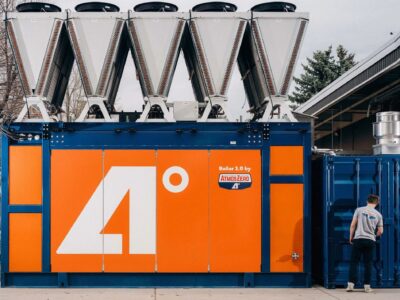At the 2023 Alaska State Fair, held Aug. 18 to Sept. 4, a pumpkin the size of a small car stole the show. The giant gourd, along with a 130-pound cabbage, a zucchini close to the size of a 5-year-old, and other supersized produce, is a direct result of Alaska’s agricultural sector.
No, it’s not GMOs; these vegetables are all-natural, grown strictly from a diet of sun, water, and fertilizer. How do these farmers get their vegetables to be so big then?
A University of Alaska educator of agriculture explained that giant produce is a part of the cultural identity of Alaska. A feeling of everything is bigger in the state where the land is not as hospitable year-round, where hard work pays off. Professor Stephen Brown also wrote a book about the giant vegetable craze.
The Business Download spoke with Brown to learn more about why Alaskans love to grow huge produce. He said we can trace the lineage of the flagship contest — the cabbage competition — to the earliest American settlers in Alaska.
The Russian settlers there were already growing large cabbages, and the Americans thought it would be fun to compare them. It started as a 12-pound cabbage. Now, they are as big as 135 pounds, Brown explained.
And Alaskans truly feel that these vegetable embody their spirit. “Alaskans love to pick on Texans for thinking they have the biggest everything,” he joked.
Originally from Texas, Brown was no stranger to the moniker “Everything is bigger in Texas.” For the last 15+ years, he has worked in precision agriculture through the University of Alaska Fairbanks while also serving as a mountaineer for the Alaskan mountain climbing industry.
A fact sheet by him and his wife, Eva Cohnen-Brown, explains how soil is extremely fertile in Alaska. The summer weather is the optimal temperature for crops to thrive, with the area providing plenty of rain. 2023 was the wettest year in Alaska to date.
Twenty hours of daylight also gives these plants plenty of time to complete photosynthesis. While the sun may not be shining as bright as some locations, there is still enough sunlight to help giant pumpkins out of the ground. He says that genetics also play a role in the size.
Brown also outlines how to care for extra-large cabbages, get them out of the ground, and successfully transport them. The giant vegetable contest at the Alaska State Fair is a big deal. People will haul these behemoths on trailers or in the back of pickup trucks — it’s no joke.
Photo Courtesy Megan Brown
Growing the vegetables is the hardest part. Farmers don’t have a big window to do so, with Alaska’s summer only being two months maximum.
However, the precipitation and fertile soil are so good the farmers may not need as much time. The fertilizer farmers use is typically all-natural, made up of manure from livestock like cows and goats. Farmers have to keep moose and deer from snacking on their crops, which is a challenge in itself.
Still, Alaska’s wet, cooler climate is ideal for cabbages to thrive. The same could be said for squash, potatoes, and broccoli. Alaska generates larger produce than any state in the Lower 48. That’s a testament to the health of the land. Farmers also speculate these conditions are what give Alaskan vegetables such strong flavor.
When asked whether he thinks farmers should send the vegetables to the Lower 48, Brown said, “You know, I hadn’t thought about that. We should market them to the chefs in California!”
All the produce is donated to various causes after the completion of the fair. The potatoes, kale, cauliflower, and broccoli are given to the Mat-Su Senior Service Center, Alaska’s largest senior care provider. Leafy greens, gourds, and cabbage are given to the Alaska Wildlife Conservation Center. The moose, deer, caribou, and bears enjoy the vegetation greatly.
Brown said the Mat-Su Valley area is becoming the “bread basket of Alaska” due to rising temperatures.
Climate change is having a profound impact on Alaska, as food security becomes a real issue for Alaska’s interior. However, he also believes this is a chance for the state to become America’s next big grain hub.
“We see Alaska as the new Midwest,” he said.
Photo Courtesy Shivam Kumar
Unfortunately, no records were set this year. First place in the largest pumpkin contest went to Dale Marshall of Anchorage at 2,023.5 pounds. Scott A. Robb of Palmer won with his 113-pound plant in the cabbage category.
“A lot of family dynasties compete in the competition. It’s pretty much a known fact who will win the contest each year,” Brown said. Most people eye second or third place. A Top Five finish for a vegetable is considered a good year for the grower, he said.
Many of the growers aren’t full-time farmers. Some are gardeners who work in other trades but grow giant vegetables for a bit of fun. Brown and his wife are a great example of this.
The impressive haul of vegetables can serve as a testament to the agricultural powerhouse Alaska could become. Even with only a short growing season, it’s clear the Alaskan land is much more fertile than ever anticipated. That will be good to have, especially with soil erosion and pollution still a real threat in parts of the U.S.
The 2024 Alaska State Fair will be held from Aug. 16 to Sept. 2. Several publications have described it as one of the country’s best state fairs, and you could see these behemoth pumpkins and cabbages for yourself.





